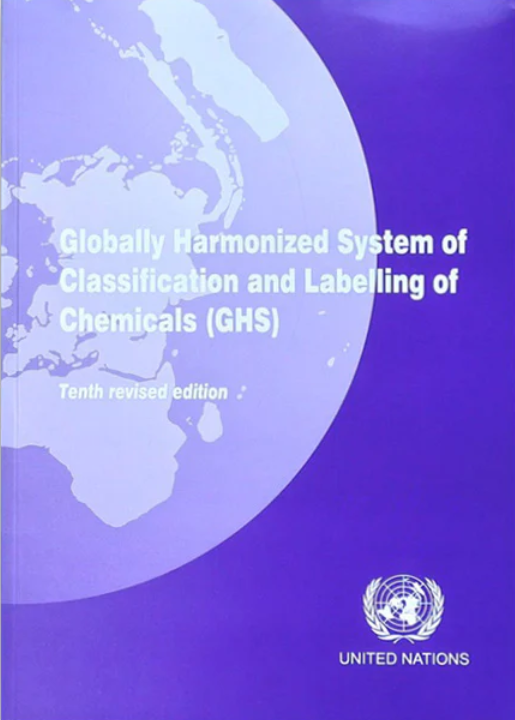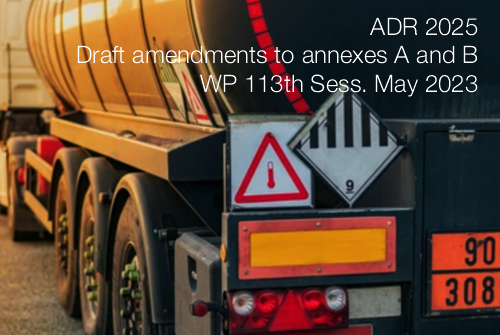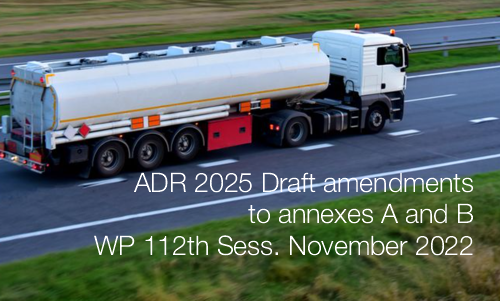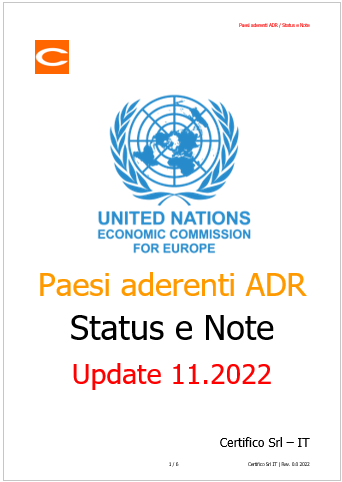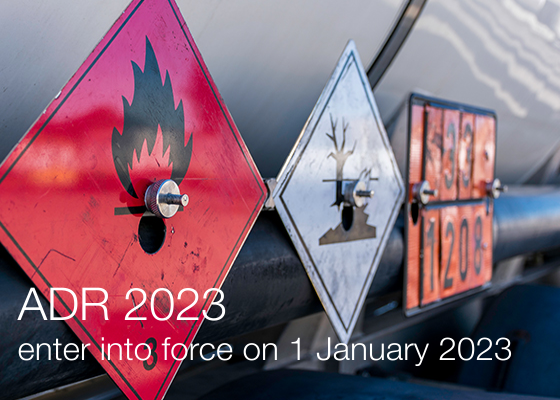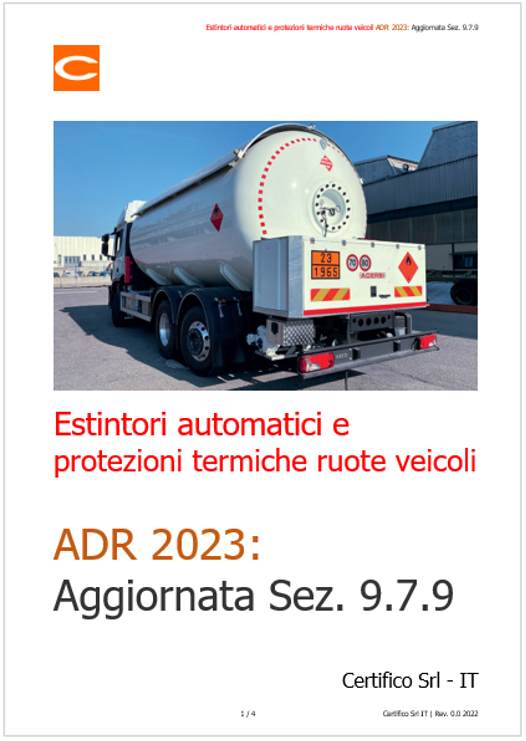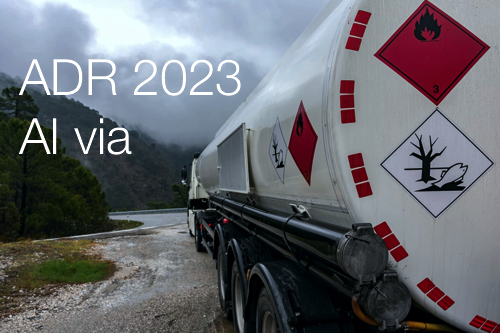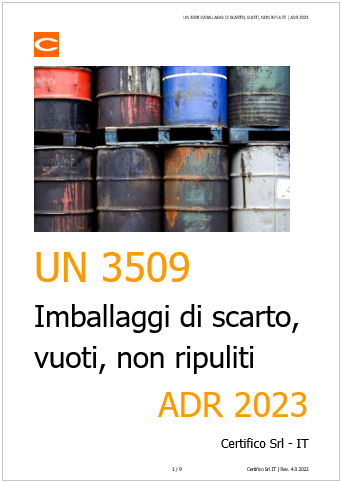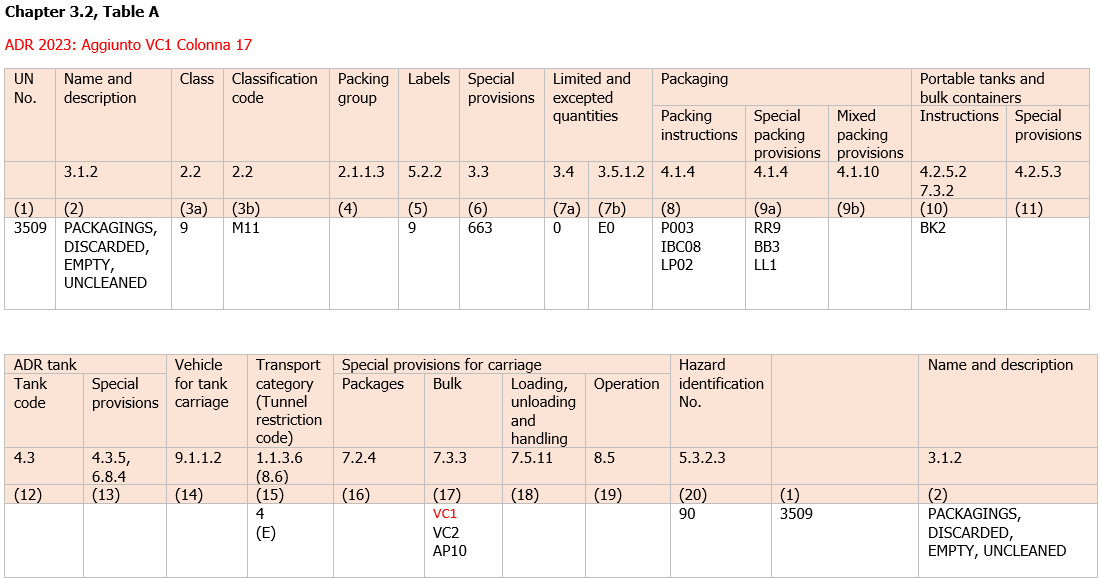Safety ADR / Dangerous Goods App
Safety ADR© è un’app per il trasporto di merci pericolose ADR che consente di:
– visualizzare tutta la Tabella A cap. 3.2 ADR per ONU/denominazione/classe/altro* (Italiano, Inglese);
– compilare per ciascuna materia ADR il “Report materia” con il parametro “Safety” (1) (Italiano, Inglese);
– compilare per ciascuna materia ADR la “Tremcards P.0” (2) (Italiano, Inglese);
– consultare le Istruzioni Scritte secondo l’ADR (Inglese, Italiano, Francese, Russo, Danese, Lettone, Norvegese, Svedese, Tedesco, Ungherese, Romeno, Portoghese, Ceco, Spagnolo, Turco, Sloveno, Slovacco, Estone, Neerlandese (Belgio), Neerlandese (Paesi Bassi), Polacco, Finlandese, Lituano, Bulgaro, Greco, Serbo);
– avere news in tempo reale visualizzate direttamente in Home;
– consultare l’accordo ADR (Inglese, Francese);
– consultare le etichette ADR, le classi, i Kemler (Italiano, Inglese).
GHS Rev. 10 July 2023
GHS Rev. 10 Luglio 2023 / Globally Harmonized System of Classification and Labelling of Chemicals / 10a Ed. 2023
Globally Harmonized System of Classification and Labeling of Chemicals (GHS): Tenth Revised Edition The GHS addresses the classification of chemicals by types of hazards and wants to harmonize those types of hazards, including labels and safety data sheets. It aims to ensure that information on physical hazards and toxicity from chemicals is the best possible for the protection of human health and the environment during handling, transport and use.
The GHS also provides a basis for the harmonization of national, regional and global chemicals standards and regulations. In its 11th session (9 December 2022), the “Committee of Experts on the Transport of Dangerous Goods and the Globally Harmonized System and Labeling of Chemicals” introduced a number of amendments to the revised 9th edition of the GHS addressing, among other topics:
– the classification procedure for desensitized explosives (chapter 2.17);
– the use of non-animal test methods for the classification of health hazards, in particular: skin corrosion/irritation (chapter 3.2), serious eye damage/irritation (chapter 3.3) and respiratory or skin sensitization (chapter 3.4);
– further streamlining of the precautionary statements to improve user comprehensibility, taking into account usability for labeling professionals; And
– the revision of annexes 9 and 10 to ensure the alignment of the classification strategy, guidelines and tools on metals and metal compounds with the provisions for long-term toxicity of aquatic classification in chapter 4.1.
Add more
Eurotunnel’s dangerous goods guide 2023
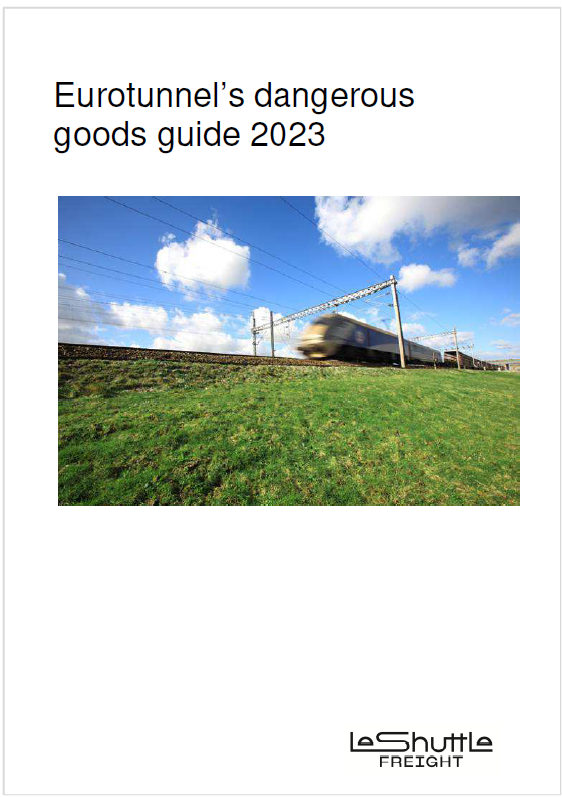
Eurotunnel’s dangerous goods guide 2023
Contents
I – Introduction to Eurotunnel’s dangerous goods policy
II – Definition of terms used
III – List of dangerous goods accepted
Class 1: Explosive substances and articles
Class 2: Gases: compressed, liquefied or dissolved under pressure
Class 3: Flammable liquids
Class 4.1: Flammable solids
Class 4.2: Substances liable to spontaneous combustion
Class 4.3: Substances, which in contact with water, emit flammable gases
Class 5.1: Oxidizing substances
Class 5.2: Organic peroxides
Class 6.1: Toxic substances
Class 6.2: Infectious substances
Class 7: Radioactive materials
Class 8: Corrosive substances Class 9: Miscellaneous dangerous substances and articles
IV – What to do on arrival at the Freight Terminal
V – Eurotunnel contact details
I – Introduction to Eurotunnel’s dangerous goods policy
The Channel Tunnel has been designed to be one of the safest transport systems known to date. Eurotunnel’s dangerous goods policy is therefore intended to ensure the safety of its customers and staff, and the integrity of the Tunnel.
This policy has been produced in close collaboration with industry and with relevant trade and professional bodies.
The carriage of dangerous goods through the Channel Tunnel must comply with ADR (Agreement concerning the International Carriage of Dangerous Goods by Road). Dangerous goods definitions are subject to the current revision of the ADR regulations and Eurotunnel Freight will accept, restrict or refuse goods on the basis of these definitions.
This dangerous goods policy has been decreed by a By-Law in the UK and an Arrêté Ministériel in France and forms an integral part of Eurotunnel’s Conditions of Carriage. The carriage of dangerous goods must also comply with Eurotunnel’s own regulations as described on this website, which are more stringent than those in ADR, to reflect the specific safety characteristics of the Channel Tunnel infrastructure.
The carrier is responsible for ensuring that the goods being transported comply with these regulations.
Declarations must be made using the current revision of ADR applicable at the time of travel, in one of the official languages of ADR – English, French or German. Furthermore, it is also the carrier’s responsibility to provide the compulsory documentation, including for vehicles travelling under the provisions of ADR chapter 1.1.3.6.
Dangerous goods being carried under the ADR Limited Quantity, Excepted Quantity or any other Special Provisions, which do not need documentation, do not need to be declared at Check-in.
However, if these goods are declared, a full ADR declaration must be provided.
Eurotunnel Freight reserves the right to authorise or refuse carriage of dangerous goods via Eurotunnel Freight, irrespective of their type, origin and / or destination. The Channel Tunnel has been designed to be one of the safest transport systems known to date.
…
Add more
ADR 2025 Draft amendments to annexes A and B | WP 113th Sess. May 2023
Accordo multilaterale M351: Esenzione nomina consulente ADR speditori di merci poco pericolose
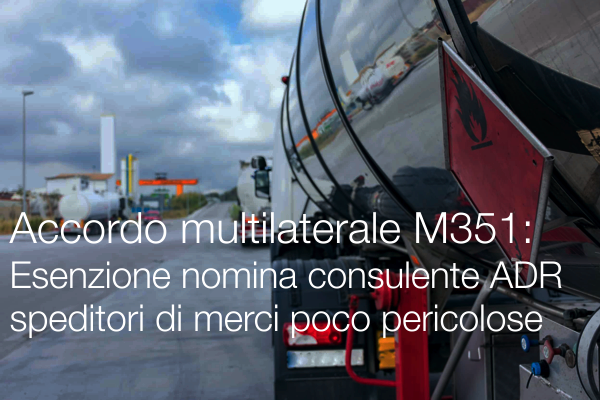
Accordo multilaterale M351: Esenzione nomina del consulente ADR speditori merci poco pericolose / Genn. 2023
08.02.2023 / Avviato dal Regno Unito il 10 gennaio 2023 – Allegato
______
MU351 / IT
M351 – Esenzione dalla nomina di un consulente per la sicurezza per gli speditori – ADR 1.8.3.2 (b)
ACCORDO MULTILATERALE M351 Ai sensi della sezione 1.5.1 dell’ADR, concernente l’esenzione dalla nomina di un consulente per la sicurezza per gli speditori – ADR 1.8.3.2 (b)
1. In deroga alle disposizioni del comma 1.8.3.2 dell’ADR, relative alle esenzioni dalla nomina di un consulente per la sicurezza per il trasporto di merci pericolose, il presente Accordo Multilaterale prevede che si applichi anche l’esenzione prevista dall’ADR 1.8.3.2 (b) alle imprese la cui attività principale o secondaria non è la spedizione di merci pericolose, ma che effettuano occasionalmente spedizioni nazionali di merci pericolose che presentano un pericolo o un rischio di inquinamento minimo.
2. Il presente accordo è valido fino al 31 dicembre 2024 per il trasporto nei territori delle Parti contraenti dell’ADR firmatarie del presente accordo. Se revocato prima di tale data da uno dei firmatari, resterà valido fino alla suddetta data solo per il trasporto sui territori delle Parti contraenti ADR firmatarie del presente accordo che non lo abbiano revocato.
_______
Update 23.02.2023 – Italia firma M351, concernente l’esenzione dalla nomina di un consulente per la sicurezza per gli speditori – ADR 1.8.3.2 (b)
Update 14.02.2023 – San Marino firma M351, concernente l’esenzione dalla nomina di un consulente per la sicurezza per gli speditori – ADR 1.8.3.2 (b)
MU351 / EN
M351 – Exemption from appointing a safety adviser for consignors – ADR 1.8.3.2 (b) (Initiated by United Kingdom on 10 January 2023)
MULTILATERAL AGREEMENT M351
Under section 1.5.1 of ADR, concerning the exemption from appointing a safety adviser for consignors – ADR 1.8.3.2 (b)
351 – Exemption from appointing a safety adviser for consignors – ADR 1.8.3.2 (b) (Initiated by United Kingdom on 10 January 2023)
| COUNTRY | SIGNED | REVOKED |
| United Kingdom | 10/01/2023 | |
| San Marino | 13/02/2023 | |
| Italia | 23/02/2023 |
Valid until 31 December 2024
1. By derogation from the provisions of sub-section 1.8.3.2 of ADR, relating to exemptions from appointing a safety adviser for the carriage of dangerous goods, this Multilateral Agreement provides that the exemption within ADR 1.8.3.2 (b) shall also apply to undertakings the main or secondary activities of which are not the consignment of dangerous goods but which occasionally engage in the national consignment of dangerous goods posing little danger or risk of pollution.
2. This agreement shall be valid until 31 December 2024 for the carriage on the territories of those ADR Contracting Parties signatory to this agreement. If it is revoked before then by one of the signatories, it shall remain valid until the above-mentioned date only for carriage on the territories of those ADR Contracting Parties signatory to this agreement which have not revoked it.
– Nota MIT prot. 40141 del 21.12.2022
ADR 1.8.3.2.
Le autorità competenti degli Stati membri possono prevedere che le presenti disposizioni non si applichino alle imprese:
a) le cui attività riguardano quantità limitate, per ogni unità di trasporto, non superiori ai limiti definiti a 1.1.3.6 e 1.7.1.4 come pure ai capitoli 3.3, 3.4 e 3.5; ovvero:
b) che non effettuano, a titolo di attività principale o accessoria, trasporti di merci pericolose od operazioni d’imballaggio, di riempimento, di carico o scarico connesse a tali trasporti, ma che effettuano occasionalmente trasporti nazionali di merci pericolose, od operazioni d’imballaggio, di riempimento, di carico o scarico connesse a tali trasporti che presentano un grado di pericolosità o un rischio di inquinamento minimi.
M351 – Exemption from appointing a safety adviser for consignors – ADR 1.8.3.2 (b) (Initiated by United Kingdom on 10 January 2023)
Valid until 31 December 2024
MULTILATERAL AGREEMENT M351 Under section 1.5.1 of ADR, concerning the exemption from appointing a safety adviser for consignors – ADR 1.8.3.2 (b)
1. By derogation from the provisions of sub-section 1.8.3.2 of ADR, relating to exemptions from appointing a safety adviser for the carriage of dangerous goods, this Multilateral Agreement provides that the exemption within ADR 1.8.3.2 (b) shall also apply to undertakings the main or secondary activities of which are not the consignment of dangerous goods but which occasionally engage in the national consignment of dangerous goods posing little danger or risk of pollution.
2. This agreement shall be valid until 31 December 2024 for the carriage on the territories of those ADR Contracting Parties signatory to this agreement. If it is revoked before then by one of the signatories, it shall remain valid until the above-mentioned date only for carriage on the territories of those ADR Contracting Parties signatory to this agreement which have not revoked it.
ADR 2023: files and amendments
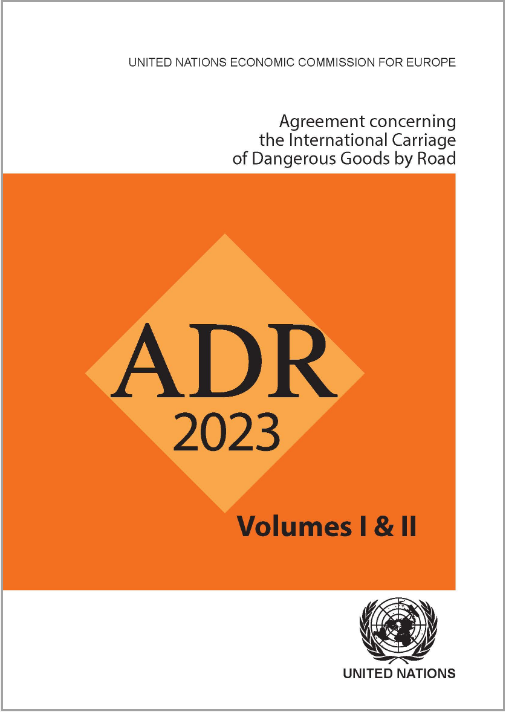
Agreement concerning the International Carriage of Dangerous Goods by Road (ADR 2023)
The ADR is a regulatory instrument that applies to international transport in 53 countries. it applies to national transportation by road in many countries (in particular the countries of the European Union).
The ADR lays down requirements for transport operations, driver training and the construction and approval of vehicles. The 2023 edition has been prepared on the basis of amendments which are set to enter into force on 1 January 2023, after acceptance by the Contracting Parties.
Author: UNECE
Publication date: October 2022
Page count: 1344
Language(s) in this book: English
Sales number: 22.VIII.2
Fonte: UNECE
ADR 2025 Draft amendments to annexes A and B | WP 111th Sess. November 2022
Paesi aderenti ADR: Status e Note / Update 11.2022
Paesi aderenti ADR: Status e Note / Update 11.2022
ID 17967 | 01.11.2022 / Elenco in allegato
Agreement concerning the International Carriage of Dangerous Goods by Road (ADR)
Status: 01.11.2022 / n. 54 – Fonte UNECE
Sono 54 i Paesi del mondo aderenti all’ADR, in allegato elenco con Status/Modalità e Note.
| Ultimi | Data | Modalità |
| Uganda | 23 Aug 2022 | Accession |
| Armenia | 12 Apr 2022 | Accession |
Agreement concerning the International Carriage of Dangerous Goods by Road (ADR 2023)
Agreement concerning the International Carriage of Dangerous Goods by Road (ADR 2023)
28 October 2022
The ADR is a regulatory instrument that applies to international transport in 53 countries. it applies to national transportation by road in many countries (in particular the countries of the European Union).
The ADR lays down requirements for transport operations, driver training and the construction and approval of vehicles. The 2023 edition has been prepared on the basis of amendments which are set to enter into force on 1 January 2023, after acceptance by the Contracting Parties.
Author: UN, ECE
Publication date: October 2022
Page count: 1344
Language(s) in this book: English
Sales number: 22.VIII.2
This publication can be obtained from distributors of United Nations Publications or from the Sales Office (see how to order).
Fonte: UNECE
ADR 2023: enter into force on 1 January 2023
ADR 2023: enter into force on 1 January 2023
Reference: C.N.350.2022.TREATIES-XI.B.14 (Depositary Notification)
AGREEMENT CONCERNING THE INTERNATIONAL CARRIAGE OF DANGEROUS GOODS BY ROAD (ADR) GENEVA, 30 SEPTEMBER 1957 ENTRY INTO FORCE OF AMENDMENTS PROPOSED BY FRANCE TO ANNEXES A AND B, AS AMENDED (1)
The Secretary-General of the United Nations, acting in his capacity as depositary, communicates the following: By 6 October 2022, none of the Contracting Parties to the above-mentioned Agreement had communicated an objection to the Secretary-General. Consequently, in accordance with the provisions of article 14 (3) of the Agreement, the proposed amendments to annexes A and B, as amended, shall enter into force for all Contracting Parties on 1 January 2023.
(1) Refer to depositary notification C.N.171.2022.TREATIES-XI.B.14 of 6 July 2022 (Proposal of Amendments by France to annexes A and B, as amended).
Estintori automatici e protezioni termiche ruote veicoli ADR 2023
Estintori automatici e protezioni termiche ruote dei veicoli ADR 2023: Aggiornata Sez. 9.7.9
ID 17835 | 14.10.2022 / Documento completo allegato
Estesi i requisiti di sicurezza per i veicoli relativi ai sistemi automatici di estinzione e protezioni termiche incendio delle ruote già applicati ai veicoli di tipo EX/III, ora anche ai veicoli di tipo FL, ma solo se destinati al trasporto di gas infiammabili e di liquidi infiammabili a medio-alta pericolosità (Codice di classificazione che include la lettera F).
(in rosso novità ADR 2023)
9.7.9 Prescrizioni di sicurezza supplementari relative ai veicoli FL e EX/III
A seguire confronto Sez 9.7.9 ADR 2021 / ADR 2023:
| ADR 2021 | ADR 2023 |
| PARTE 9 – PRESCRIZIONI RELATIVE ALLA COSTRUZIONE E ALL’APPROVAZIONE DEI VEICOLI | |
| CAPITOLO 9.7 – Prescrizioni supplementari relative alle cisterne fisse (veicoli-cisterna), veicoli-batteria e veicoli completi o completati utilizzati per il trasporto di merci pericolose in cisterne smontabili di capacità superiore a 1 m3 o in contenitori-cisterna, cisterne | |
| 9.7.9. Prescrizioni di sicurezza supplementari relative ai veicoli FL e EX/III | 9.7.9. Prescrizioni di sicurezza supplementari relative ai veicoli FL e EX/III |
| 9.7.9.1. I veicoli EX/III devono essere equipaggiati di estintori automatici per il compartimento motore. |
9.7.9.1. I seguenti veicoli devono essere equipaggiati con sistemi automatici di estinzione incendio per il compartimento in cui si trova il motore a combustione interna che aziona il veicolo: (a) veicoli FL che trasportano gas infiammabili compressi e liquefatti con codice di classificazione che include la lettera F; (b) veicoli FL che trasportano liquidi infiammabili di gruppo di imballaggio I o di gruppo di imballaggio II; e (c) veicoli EX/III. |
| 9.7.9.2 La protezione del carico dagli incendi degli pneumatici deve essere assicurata da schermi termici di metallo |
9.7.9.2 I seguenti veicoli devono essere equipaggiati con protezioni termiche in grado di mitigare la propagazione di un incendio originato da tutte le ruote: (a) veicoli FL che trasportano gas infiammabili compressi e liquefatti con codice di classificazione che include la lettera F;(b) veicoli FL che trasportano liquidi infiammabili di gruppo di imballaggio I o di gruppo di imballaggio II; e (c) veicoli EX/III.NOTA: lo scopo è quello di evitare la propagazione dell’incendio al carico, ad esempio con schermi termici o altri sistemi equivalenti, sia: (a) per propagazione diretta dalla ruota al carico; o (b) per propagazione indiretta dalla ruota alla cabina e poi al carico. |
1.6.5 Misure transitorie
Il Capitolo 1.6.5 Misure transitorie – 1.6.5 Veicoli, aggiunti 1.6.5.23, 1.6.5.24 e 1.6.5.25 che stabiliscono 6 anni di transitorio fino 2029 per i veicoli non conformi:
1.6 Misure transitorie
1.6.5 Veicoli
…
1.6.5.23 I veicoli EX/III immatricolati per la prima volta o messi in servizio prima del 1° gennaio 2029, in conformità alle prescrizioni del 9.7.9.2 applicabile fino al 31 dicembre 2022, ma che non sono conformi alle prescrizioni del 9.7.9.2 applicabili dal 1° gennaio 2023, possono continuare ad essere utilizzati.
1.6.5.24 I veicoli FL immatricolati per la prima volta o messi in servizio prima del 1° gennaio 2029, che non sono conformi alle prescrizioni del 9.7.9.1 applicabili dal 1° gennaio 2023, possono continuare ad essere utilizzati.
1.6.5.25 I veicoli FL immatricolati per la prima volta o messi in servizio prima del 1° gennaio 2029, che non sono conformi alle prescrizioni del 9.7.9.2 applicabili dal 1° gennaio 2023, possono continuare ad essere utilizzati.
…
Vedi tutto
ADR 2023: Al via la procedura di approvazione con la comunicazione UNECE / ONU
ADR 2023: Al via la procedura di approvazione con la comunicazione UNECE / ONU
ID 17031 | 07.07.2022 / In allegato Comunicazione
Come da procedura (Art. 14 paragrafo 1 ADR), il Segretario Generale dell’ONU ha comunicato in data 6 Luglio 2022 con nota C.N.171.2022.TREATIES-XI.B.14, di aver ricevuto dalla Francia (WP.15 Chief Secretary UNECE), il testo degli emendamenti all’ADR che dovranno entrare in vigore il 1° gennaio 2023.
Emendamenti relativi alle sessioni WP.15:
– 108th session (10-13 November 2020)
– 109th session (04-07 May 2021)
– 110th session (08-12 November 2021)
– 111th session (09-13 May 2022)
Emendamenti trasmessi:
ECE/TRANS/WP.15/256
ECE/TRANS/WP.15/256/Corr.1
ECE/TRANS/WP.15/256/Corr.2
ECE/TRANS/WP.15/256/Add.1
Se entro tre mesi (entro il 6 ottobre 2022) non vi saranno obiezioni da parte degli Stati contraenti tale testo risulterà definitivamente approvato.
ADR 2023: Draft amendments to annexes A and B | Consolidated list
In allegato la Comunicazione
ADR: il nuovo nuovo ONU 3509 Applicazione / Update ADR 2023
ADR: il nuovo nuovo ONU 3509 Applicazione / Update ADR 2023
ADR 2023, aggiornamento:
– La Disposizione Speciale 663 inerente gli imballaggi scartati, vuoti, non ripuliti
– Tabella A 3.2 nella colona (17) Disposizioni speciali relative al trasporto – Alla rinfusa inserito VC1
_______
Allegati:
– Scheda completa articolo
– Report materia 3509
– Tremcards rifiuto 150110 / 3509
UN 3509 IMBALLAGGI DI SCARTO, VUOTI, NON RIPULITI
Per l’applicazione del nuovo numero ONU 3509 sono da prendere in esame:
– La Tabella A 3.2
– La Disposizione Speciale 663
– Le informazioni da fornire nel DDT nel nuovo paragrafo 5.4.1.1.19
– L’esenzione totale 1.1.3.5
– L’esenzione parziale 1.1.3.6
_______




